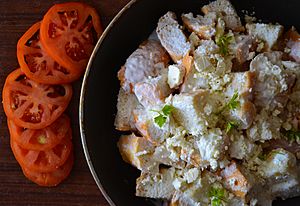Popara facts for kids
 |
|
| Alternative names | Pоpara |
|---|---|
| Course | Main dish |
| Main ingredients | Bread, sugar or honey, water or milk, kaymak, cheese |
Popara is a simple and tasty dish made mostly from bread. It's a popular meal in many countries, especially in Southeast Europe. People often make Popara using bread that is a bit old. This helps to use up bread that might otherwise be thrown away.
What is Popara?
Popara is a traditional dish that uses bread as its main ingredient. It's a bit like a bread pudding, but often savory or only slightly sweet. The word "Popara" comes from different languages in the region. It is a very old recipe, showing how people used simple ingredients to make a filling meal.
How is Popara Made?
Making Popara is quite easy. First, you take pieces of bread, usually with a thick crust. These bread pieces are then soaked in a hot liquid. This liquid can be hot tea, warm milk, or even just hot water. Soaking the bread makes it soft and easy to eat.
After the bread is soft, people often add other ingredients to make it even better. Some popular additions include:
- Sugar or honey, for a sweet taste.
- Butter, to make it richer.
- Different types of cheese, for a savory flavor.
- Sometimes, a creamy dairy product called kaymak is added.
The exact ingredients can change depending on who is making it and where they are from. This makes Popara a very flexible dish.
Where is Popara Eaten?
Popara is a common dish in several countries in Southeast Europe. You can find it in:
- Bulgaria
- Greece
- Serbia
- Bosnia and Herzegovina
- North Macedonia
- Turkey
- Montenegro
In each of these countries, Popara might have slightly different names or small changes in how it's made. But the main idea of soaking bread in a hot liquid remains the same. It's often eaten for breakfast or as a light meal.
Why is Popara Popular?
Popara has been popular for a long time for a few good reasons.
- Simple Ingredients: It uses basic ingredients that are usually easy to find.
- Prevents Waste: It's a great way to use up old or stale bread. This helps reduce food waste.
- Filling and Warm: It's a warm and satisfying meal, especially on cold days.
- Quick to Make: It doesn't take long to prepare, which is helpful for busy families.
This simple dish shows how people can create delicious and practical meals from everyday items.
See also
 In Spanish: Papara (comida) para niños
In Spanish: Papara (comida) para niños

